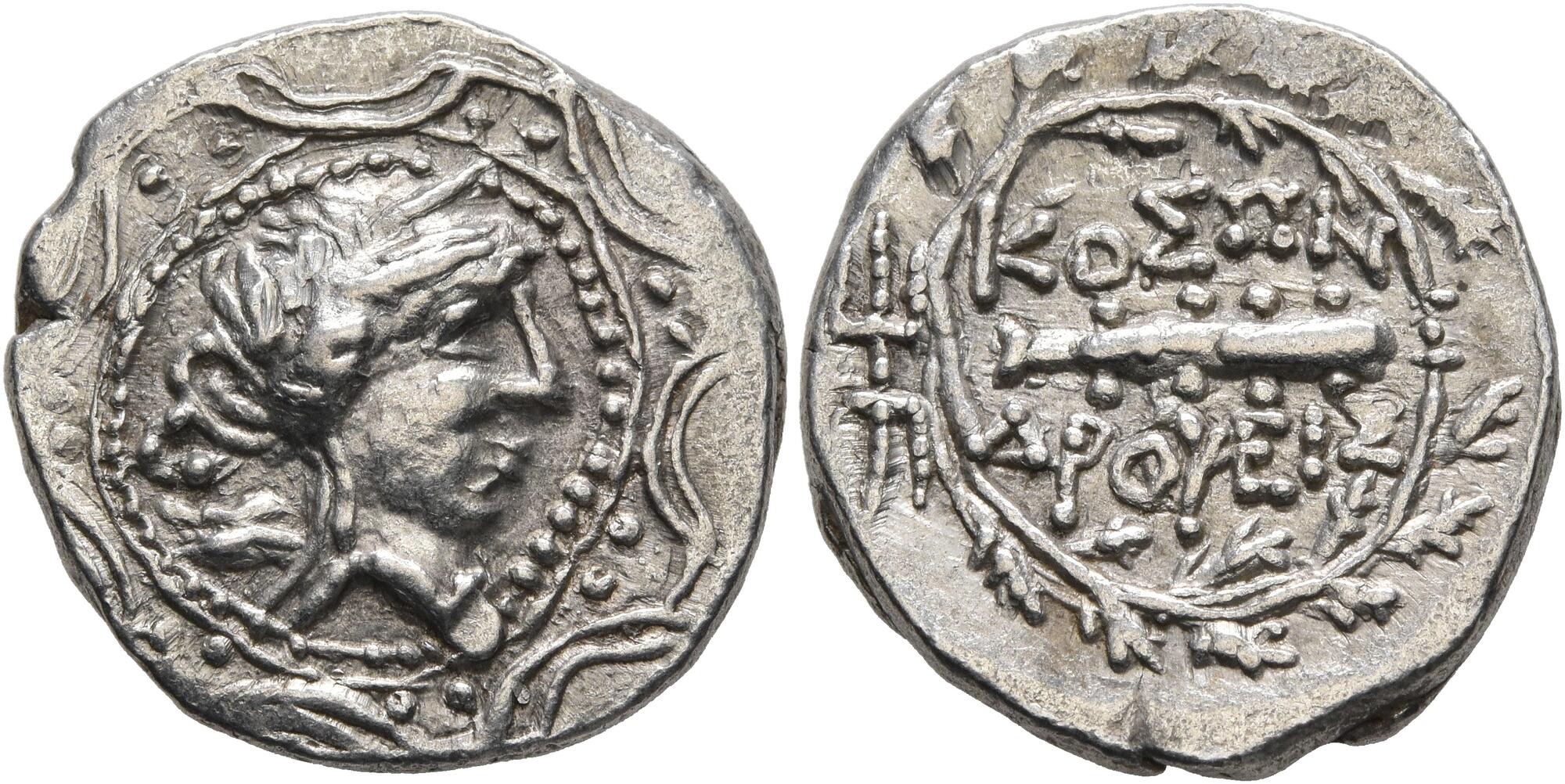S 1601 - Olbia (?) (Koson), silver, drachms (c. 50-40 BCE)
From SILVER
50 BCE - 40 BCE Silver 83 kg
Description
| ObverseInscription or printing placed on the obverse.: | Diademed and draped bust of Artemis to right, bow and quiver over her shoulder, all at the center of a Macedonian shield ornamented with stars within crescents. |
| ReverseInscription or printing placed on the reverse.: | ΚΟΣΩΝ / ΔΡΟΥΕΙΣ (Greek).Club to right, around, oak wreath with ties to left, to left of the ties, thunderbolt |
Mint and issuing power
| MintIdentifies the place of manufacture or issue of a numismatic object.: | Olbia | Ancient regionAncient region.: | Scythia | Modern countryModern country: Ukraine | AuthorityIdentifies the issuing power. The authority can be "pretended" when the name or the portrait of X is on the coin but he/she was not the issuing power. It can also be "uncertain" when there is no mention of X on the coin but he/she was the issuing power according to the historical sources: | Koson of Dacia, Marcus Junius Brutus (85-42 BCE) |
Chronology
| FromIdentifies the initial date in a range assigned in a numismatic context. | 50 BCE | toIdentifies the final date in a range assigned in a numismatic context.. | 40 BCE | PeriodTime period of the numismatic object.: Hellenistic 323-30 BC |
Physical description
| MetalThe physical material (usually metal) from which an object is made.: | Silver |
Median weightMedian of the weights of numismatic objects (in grams). in grams | 4.30 | DenominationTerm indicating the value of a numismatic object. Examples: tetradrachm, chalkous, denarius.: | drachma |
StandardStandard.: | Attic |
Image

S1601 Koson type 1.jpg [1]
References
| Die study referencePublication of the study: | Fischer-Bossert 2016b1Fischer-Bossert 2016b, Type A | ||
| Coin series referenceReference to coin series study: | |||
Obverse dies distribution
| FrequencyFrequency of specimen in distribution. ᵖ | Number of obversesNumber of obverse dies. ᵖ (o) | % (o) | Number of coinsNumber of coins. (n) | % (n) | Die nameName(s) of the die(s). |
| 37 | 1 | 100 | 37 | 100 | 1 |
| Total | 1 of 1 | 100 | 37 of 37 | 100 |
Reverse dies distribution
no distribution is available
Quantification
| Number of obversesNumber of obverse dies. ᵖ (o) | 1 | Number of singletons (o1)The number of singleton coins. ᵖ | |
| Number of reverse diesNumber of reverse dies. (r) | 1 | Number of coinsNumber of coins. (n) | 37 |
| Coins per obverse dieNumber of coins per obverse die. (n/o) | 37 | Coins per reverse dieNumber of coins per reverse die. (n/r) | 37 |
| Reverse per obverse ratioRatio of obverse dies divided by reverse dies. (r/o) | 1 | Percentage of singletons (o1)number of coins (n) divided by the number of singletons (o1) ᵖ | % |
| Original number of dies (O) (Carter 1983 formula)The estimation of the number of coins according to Carter 1983 ᵖ | 0.96 | Coins struck if 20,000 as average productivity per dieCoins made if the average productivity for obverses (according to Carter) is 20,000. ᵖ | 19,200 |
| Original number of dies (O) (Esty 2011 formula)The estimation of the number of coins according to the singleton formula in Esty 2011 ᵖ (O) | 1.03 | Survival rate if 20,000 as average productivity per dieSurvival rate if average productivity is 20,000. ᵖ | 0.00193 |
| Coverage (o = % of O) (Esty 1984 formula)Esty 1984 - coverage (% of O) ᵖ (o = % of O) | % | Die productivity if survival rate 1/2,000Average productivity if survival rate is 1/2,000. ᵖ | 77,083.33 |
| Weight of silver (in kg) if 20,000 coins per die (O = Carter formula)Carter 1983 * Median weight * 20000 (*10 if gold or electrum) ᵖ | 83 kg <br /> 83 kg | Die productivity if survival rate 1/5,000Average productivity if survival rate is 1/5,000. ᵖ | 192,708.33 |
Remarks